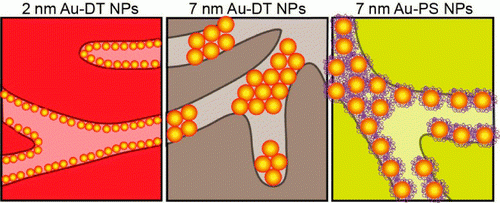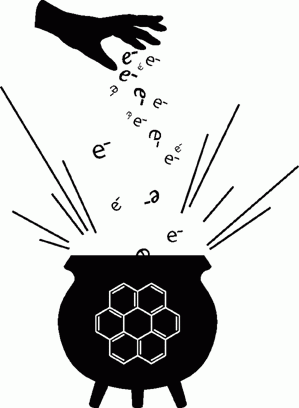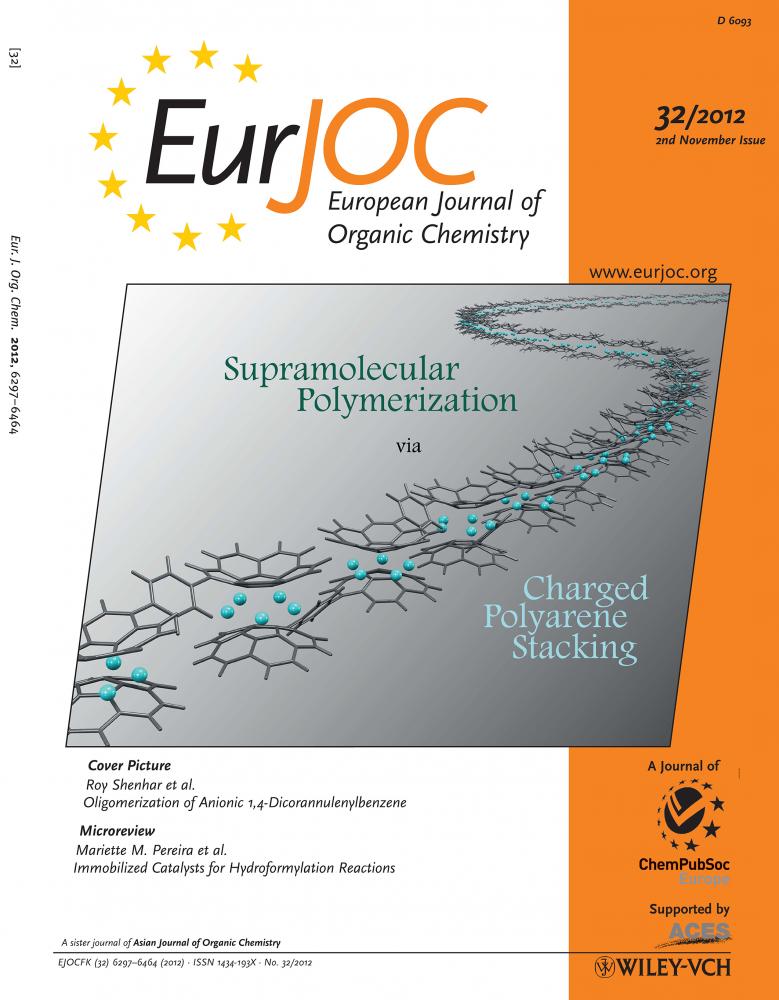Davidi, I. ; Semionov, A. ; Eisenberg, D. ; Goobes, G. ; Shenhar, R. Mesomorphic behavior induced by stacking interactions between poly(2-vinyl pyridine) and palladium pincer surfactants in the solid state.
Soft Matter 2012,
8 7393-7401.
AbstractCombining poly(2-vinyl pyridine) (P2VP) with organometallic surfactants based on a Pd-SCS pincer complex in the solid state leads to the formation of mesomorphic structures even with the lack of coordinative bonding between the pyridine groups and the surfactant molecules. Through a combination of spectroscopic methods and quantum chemical calculations we reveal that the interaction responsible for the formation of the supramolecular, comb polymer architectures leading to these mesomorphic structures is a dipolar stacking interaction between the Pd-C bond of the surfactant and the pyridine ring of the polymer. This conclusion is further supported by comparison to a system where coordinative binding between the surfactant and the polymer was induced. Additional DSC analysis shows that, unlike the system featuring coordinative binding, the weak binding to the polymer through dipolar stacking facilitates the crystallization of the alkyl residues. Such organized assemblies of metal precursors can serve for the creation of hybrid materials and organized nanocomposites.

Pavan, M. J. ; Ploshnik, E. ; Shenhar, R. Nanoparticle Assembly on Topographical Polymer Templates: Effects of Spin Rate, Nanoparticle Size, Ligand, and Concentration.
Journal of Physical Chemistry B 2012,
116, 13922-13931.
AbstractThe ability to assertible nanoparticles (NPs) into desired patterns. in a controlled fashion is crucial for the study. of collective properties and for the fabrication of a variety of devices. Drying mediated assembly directed by a template provides a facile route for organizing NPs in predefined patterns. We utilize the. branched topographical landscapes displayed by partially crystallized poly(ethylene glycol) (PEG) films as a generic template for studying. the drying mediated organization of dodecanethiol- and polystyrene thiol-protected gold NPs (Au-DT and Au-PS), and explore the combined effects of NP size and ligand, concentration, and spin rate on the distribution. of NPs inside the channels. We Show how NP concentration and the spin rate applied during NP deposition can be used to influence the tendency of NPs either to fill channel uniformly or to localize near the channel edges, explain the important role of the enhanced aggregation tendency of larger NPs on the resulting morphologies, and demonstrate how this tendency can be tuned by the proper choice Of ligands. The different effects are explained in the context of possible scenarios of drying mediated assembly by analyzing the relevant interactions and forces acting on the NPs during solvent evaporation.

Eisenberg, D. ; Shenhar, R. Polyarene anions: interplay between theory and experiment.
Wiley Interdisciplinary Reviews-Computational Molecular Science 2012,
2 525-547.
AbstractPolyarenes, or polycyclic aromatic hydrocarbons (PAHs), represent a ubiquitous and heavily studied type of compounds, appealing for their interesting spectroscopic, supramolecular, organometallic, and other properties. A major branch of research is concerned with polyarene anions: their electronic and structural properties, reactivity, aromaticity, and spectroscopy. This review describes the major role of computational investigations in complementing, explaining, and guiding experimental research, and thus providing invaluable contribution to our understanding of polyarene anions. The scope of this review focuses on polyarenes composed only from sp(2)-hybridized carbons and limits the discussion to the quantum-mechanical method of calculation. The topics covered include computation-assisted characterization; choice of methods; transformations induced by reduction, including anistropic charge redistributions, reorganization of bonding structure, flattening of curved polyarenes (buckybowls), and Jahn-Teller distortion; aromaticity topics such as ring currents and aromaticity measures; reactivity, for example, toward electrophilic substitution or ring closure, acidity and basicity, and self-assembly interactions in solution and in the gas phase; and finally, spectroscopy, mainly for astrochemical research, ranging from the mid-infrared to the far-ultraviolet spectral ranges. (C) 2011 John Wiley & Sons, Ltd.

Eisenberg, D. ; Quimby, J. M. ; Ho, D. ; Lavi, R. ; Benisvy, L. ; Scott, L. T. ; Shenhar, R. Special Electronic Structure and Extended Supramolecular Oligomerization of Anionic 1,4-Dicorannulenylbenzene.
European Journal of Organic Chemistry 2012, 6321-6327.
AbstractThe chemistry of oligocorannulenes (compounds composed of two or more corannulenyl moieties) arises from the properties of each corannulenyl and from the interactions between them. Varying the linkage between the corannulenyl moieties can influence the interaction and give rise to new properties in these carbon-rich compounds. This work describes the synthesis and reduction of 1,4-dicorannulenylbenzene in which a rigid aromatic benzene spacer leads to new electronic and supramolecular behavior, as shown by NMR, EPR, and UV/Vis spectroscopy, as well as DFT calculations. Structural and energy analyses of the dianion revealed that the benzene ring modifies the electronic communication between the two bowls. To preserve the aromatic character of the benzene, conjugation between the bowls is minimized and the benzene assumes a biradical bonding pattern rather than a quinoidal one. At the octaanionic stage, self-diffusion NMR experiments revealed extended supramolecular polymerization through charged polyarene stacking. The highly charged supramolecular oligomers are composed of up to 11 monomers per chain, significantly longer than the first (bicorannulenyl) oligomers of this type. This observation constitutes a proof-of-principle for controlling this novel type of polymer through modification of the intercorannulenyl spacer.


